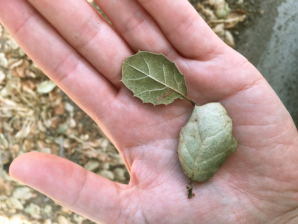Planting Under Oaks
Of the many icons of the Northern California landscape, the oak is both a beautiful and impressive individual. Both inland Valley Oaks and the Coast Live Oak can live to hundreds of years, grow into beautiful gravity-defying specimens, and support entire habitats within their surroundings. If such a tree happens to grace your landscape, you can count yourself lucky! The natural cycles of oak trees do make planting under them challenging, however. As Landscape Architects we have had quite a bit of practice, but we still have to take extra care when designing around existing oaks. Here are some tips to making your landscape beautiful while keeping the oaks healthy.
About Oaks
The two prominent species of California oaks, the Valley Oak (Quercus lobata) and the Live Oak (Quercus agrifolia), often have similar silhouettes on the horizon. One look at their leaves, though, and it is apparent that they are very different. Evergreen Live Oaks have oval leaves that curl under at the edges, and sharp little points around the edge. Deciduous Valley Oaks have softer leaves, with deep lobes making for a very wavy edge.
California Valley Oak leaves – notice the “lobed” quality
Coast Live Oak leaves – notice the “curled” quality
Oaks spread via their acorns, which are often numerous on the ground around the tree. In addition, both species tend to drop some leaves throughout the year, giving the area around the tree a persistent layer of canopy litter. Live Oaks in particular release some tannins from their leaves that can discourage the growth of plants under the tree, therefore removing most chances of competition.
Native oaks are protected by law in California. It is illegal to remove an oak in some areas unless it is approved to do so by an arborist. With this protection, oaks are being embraced as a unique part of the landscape.
Dry Seasons and Drip-Lines
If you’re a long-term California resident, you know that the chances of rain in the summer are slim. The oaks know the same, having adapted over millennia just for these conditions. For gardeners, that translates to not irrigating. While many gardeners are aware of this, they may be unaware of the extent to which irrigating around an oak can damage or even kill the trees. To be safe, most sources recommend minimal to no irrigation beneath the dripline of an oak (the dripline defined as the area that falls under the canopy of the tree.)

Diagram shows the definition of the dripline- City of Seattle Website
With that knowledge, what can you plant under an oak that requires no summer water and can handle both the shade of the canopy and the regular leaf drop? There are options, and although they provide a different look, they can bring beauty and interest to an oak’s surroundings.
Some California Native plants thrive under the shade of oaks, including Coffeeberry (Rhamnus californica) and many native ferns, especially Sword Fern (Polystichum munitum) and Giant Chain Fern (Woodwardia fimbriata). In areas that fall under the dripline but get more sun, some Manzanita (Arctostaphylos), Sage species (Salvias) Tiarella, Heuchera, and many native grasses shine.
Western Sword Fern – Photo from Fine Gardening website
Heuchera does beautifully in dry shade and can brighten up your oak understory. Not to mention, it is loved by hummingbirds!
If you have adequate sun and want some color under your oaks, many non-native Sages (Salvias) are also an excellent option. Tough Salvia greggii and hybrids such as Salvia x. ‘Waverly’ can handle the dry summers and regular leaf litter without issue. For deeper shade, Helleborus and Mahonia species will be your best friends.
Helleborus species in dry shade with Lamium
Bulbs are another option that survive on Spring rainfall alone. Cyclamen, Muscari, and some Narcissus can put on exquisite early spring shows. Although they are dormant the rest of the year, they will offer color when other plants, such as Sages, are dormant.
There are few groundcovers that will survive in these conditions inland, but if you live on the coast and receive some fog, Lamium and Rubus calycinoides are possibilities. These groundcovers can survive just about anything, but do best with partial shade and a little summer water.
Yellow Archangel (Lamium galeobdolon) has done incredibly well at the base of our Valley Oak here at the studio. We love its’ bright leaves and occasional yellow flower.
The area beneath an oak tree’s dripline can also make a wonderful seating area or site for unusual landscape features. Our Principal Architect John recently designed an exquisite labyrinth beneath a heritage oak for a unique use of space that requires no planting at all! Walking this labyrinth to its center allows contemplation and connection with the beautiful tree that watches over all, and soft landscape lighting illuminates the branches. If you think outside the box, a challenge in the landscape can become its featuring element!
For a full list of plants that survive under oaks, follow this link from Las Pilitas nursery. For help with planting plans or design around an oak in your landscape, reach out to our Alamo studio. We look forward to contributing to your Outdoor Living experience, and creating something truly unique that you will love for many years to come!












